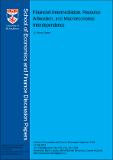Files in this item
Financial intermediation, resource allocation, and macroeconomic interdependence
Item metadata
| dc.contributor.author | Ozhan, G. Kemal | |
| dc.date.accessioned | 2017-02-23T12:30:08Z | |
| dc.date.available | 2017-02-23T12:30:08Z | |
| dc.date.issued | 2017-02-17 | |
| dc.identifier.citation | Ozhan , G K 2017 ' Financial intermediation, resource allocation, and macroeconomic interdependence ' School of Economics and Finance Discussion Paper , no. 1704 , University of St Andrews , St Andrews . | en |
| dc.identifier.issn | 0962-4031 | |
| dc.identifier.other | PURE: 249212043 | |
| dc.identifier.other | PURE UUID: 8801df07-3903-4ff3-845b-84ae5b8ff241 | |
| dc.identifier.uri | https://hdl.handle.net/10023/10342 | |
| dc.description | Financial support from the Henry T. Buechel Fellowship is acknowledged. | en |
| dc.description.abstract | This paper studies the role of the financial sector in affecting domestic resource allocation and cross-border capital flows. I develop a quantitative, two-country, macroeconomic model in which banks face endogenous and occasionally binding leverage constraints. Banks lend funds to be invested in tradable or non-tradable sector capital and there is international financial integration in the market for bank liabilities. I focus on news about economic fundamentals as the key source of fluctuations. Specifically, in the case of positive news on the valuation of non-traded sector capital that turn out to be incorrect at a later date, the model generates an asymmetric, belief-driven boom-bust cycle that reproduces key features of the recent Eurozone crisis. Bank balance sheets amplify and propagate fluctuations through three channels when leverage constraints bind: First, amplified wealth effects induce jumps in import-demand (demand channel). Second, changes in the value of non-tradable sector assets alter bank lending to tradable sector firms (intra-national spillover channel). Third, domestic and foreign households re-adjust their savings in domestic banks, and capital flows further amplify fluctuations (international spillover channel). A common central bank’s unconventional policies of private asset purchases and liquidity facilities in response to unfulfilled expectations are successful at ameliorating the economic downturn. | |
| dc.format.extent | 59 | |
| dc.language.iso | eng | |
| dc.publisher | University of St Andrews | |
| dc.relation.ispartofseries | School of Economics and Finance Discussion Paper | en |
| dc.rights | Copyright (c) 2016, the author | en |
| dc.subject | Bank lending | en |
| dc.subject | Belief-driven dynamics | en |
| dc.subject | Current account | en |
| dc.subject | Macroeconomic interdependence | en |
| dc.subject | HG Finance | en |
| dc.subject | HJ Public Finance | en |
| dc.subject | BDC | en |
| dc.subject.lcc | HG | en |
| dc.subject.lcc | HJ | en |
| dc.title | Financial intermediation, resource allocation, and macroeconomic interdependence | en |
| dc.type | Working or discussion paper | en |
| dc.description.version | Publisher PDF | en |
| dc.contributor.institution | University of St Andrews. School of Economics and Finance | en |
| dc.identifier.url | https://ideas.repec.org/p/san/wpecon/1704.html | en |
This item appears in the following Collection(s)
Items in the St Andrews Research Repository are protected by copyright, with all rights reserved, unless otherwise indicated.

